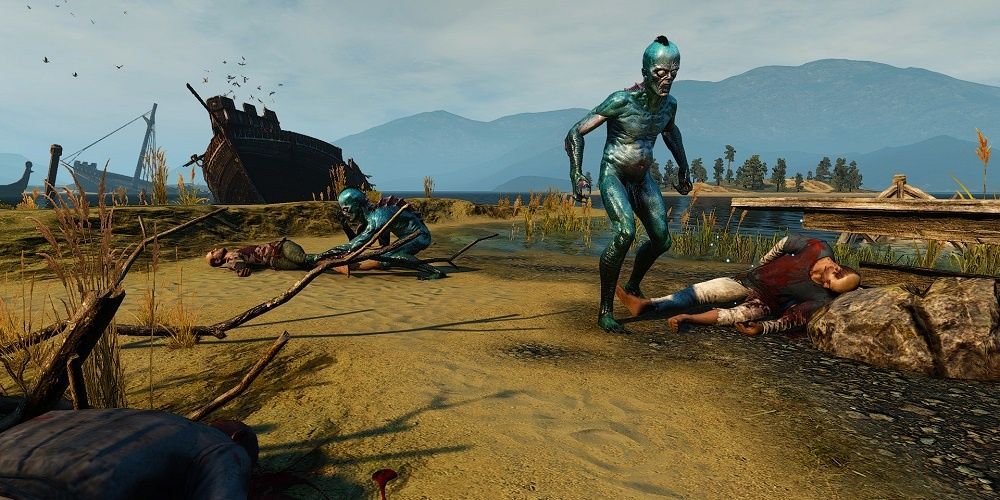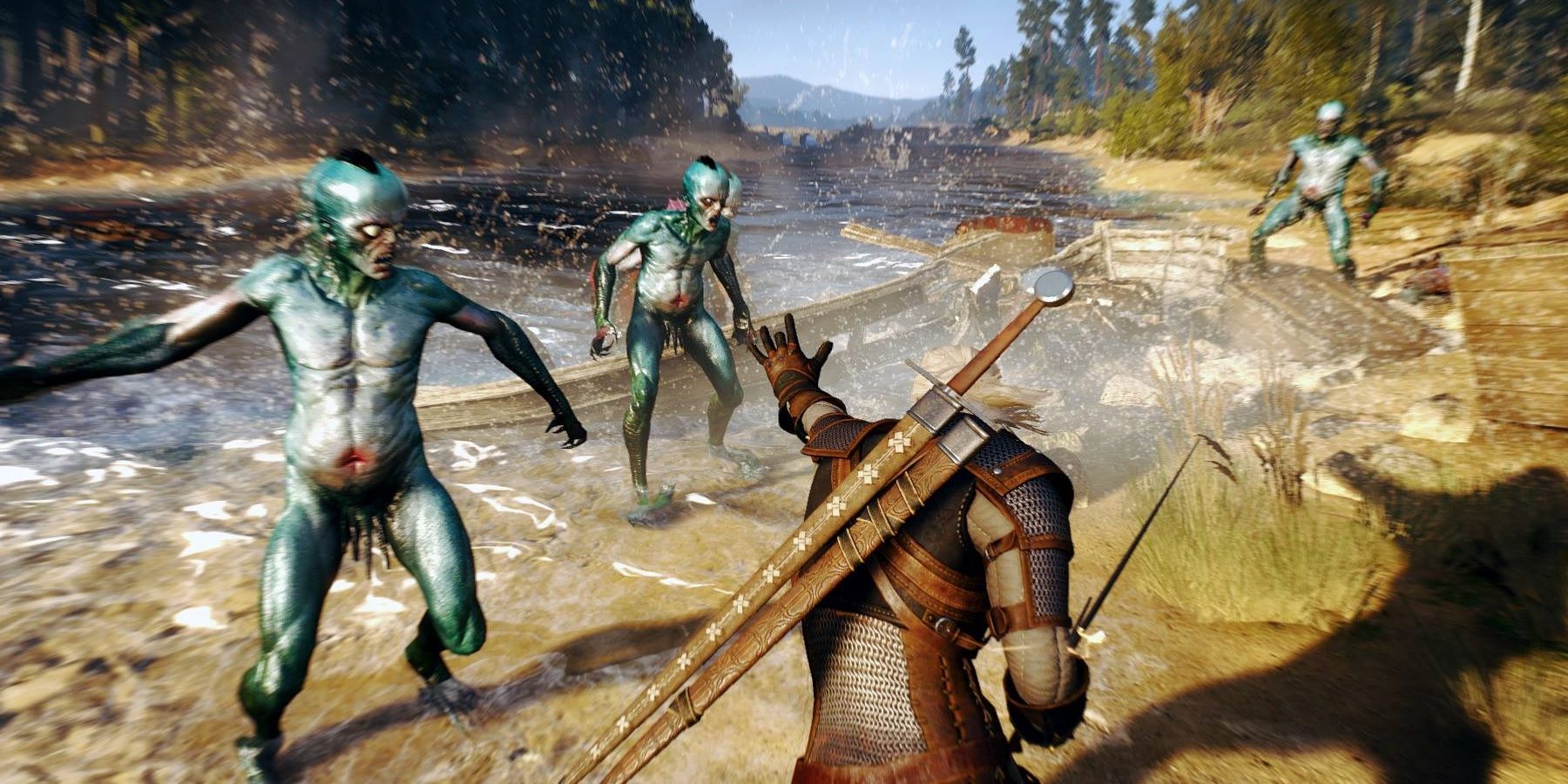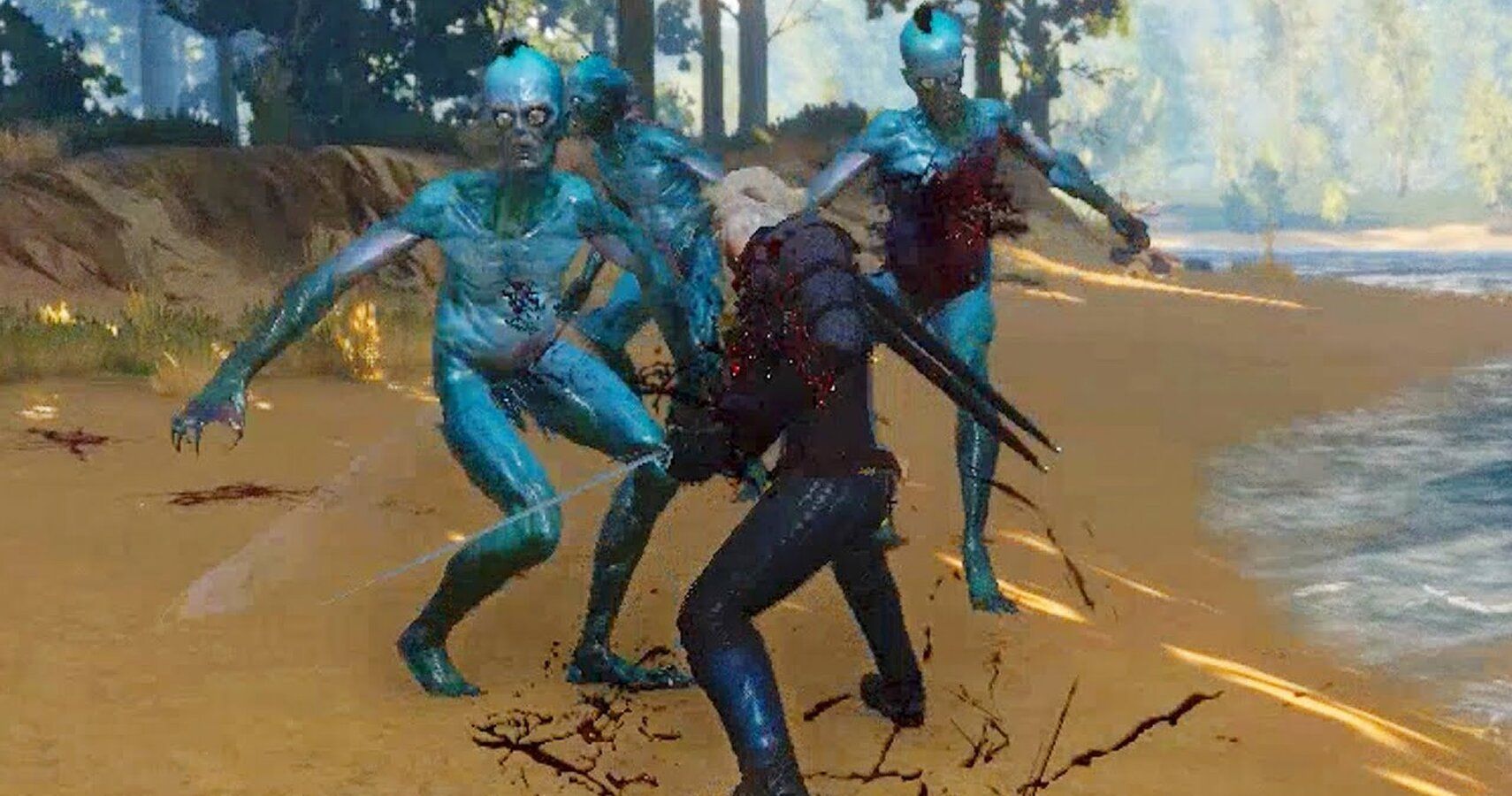Drowners are, without a doubt, the most commonly encountered monster in The Witcher 3: Wild Hunt. They’re present in every region in the game and can be found in almost any body of water. So, while they aren’t fearsome to experienced players, they’re certainly very memorable.
In The Witcher 3, drowners appear in early game areas, like White Orchard, as well as far-flung lands, like Skellige. In short, there is no escape from these creatures. In fact, they’re a staple in The Witcher game series, and not much has changed since then, save for some graphical improvements and minor details.
Water-dwelling Scavengers in The Witcher 3: Wild Hunt
Drowners are humanoid necrophages. They are bipedal with proportions similar to that of humans, which is why so many believe them to be people who perished in a watery grave. These monsters could have been travelers who fell into bogs, children who were swept away from the shore, or, really, any person who drowned in a body of water. Other variants of drowners in The Witcher 3 include the drowned dead, mucknixers, and vodniks.
However, drowners are not monstrous corpses, but a species completely separate from humankind. They are creatures that arrived after the Conjunction of the Spheres in The Witcher world. Moreover, closer inspection reveals that their physical attributes greatly differ from that of humans. Though the overall proportions are similar, drowners have bulging eyes, fish fins, gills for breathing, and slimy scales. These attributes make them excellent swimmers, which is why they often reside close to bodies of water.
Drowners in The Witcher 3 like living in waters near human settlements as this gives them a somewhat stable source of food. Though they tend to avoid humans and prefer feasting on the leftovers they dig out from the garbage or from animal remains. However, should a foolish villager wander too close to their dwelling place, drowners are not afraid to hop out from hiding to drag their victim beneath the surface. These monsters are even more emboldened on rainy days, making them more willing to leave their homes to hunt for food inland.
When drowners aren’t hungry, they’re known to keep the meat of their prey underwater for extended periods of time. This allows their food to age, growing more tender and rotten as time passes. Underwater, these creatures are far more dangerous as they circle around their prey, pulling them further beneath the surface until they run out of air. This is seen in The Witcher 3’s mechanics, and if the player isn’t careful, the drowners may fully deplete Geralt’s breath meter.
Despite appearing most often in the waters of clear lakes and rivers, drowners also have no problem residing in filthy sewer systems that run beneath The Witcher 3’s larger towns and cities. Having grown accustomed to the disgusting waters, these monsters have naturally developed a resistance to poisons. This advantage is easily negated by their mental capabilities, however. The bestiary entry describes drowners as “no more intelligent than carp or pike.” That said, they can be extremely difficult to defend against in large groups as they surround their victim and then attack from all sides.
Comparing Drowners Across The Witcher Games
The lore that’s been established for drowners is in-depth, but there is one interesting difference between The Witcher 3’s drowners and those from the older games. In The Witcher — the first game in the series — drowners are supposedly the corpses of wicked individuals who ended their lives in water or were thrown there after death. Somehow, they’re brought back to life in the form of these monsters and seek to harm the villagers of coastal settlements.
There’s even a quest in The Witcher that demonstrates this aspect of drowners. In the quest “Old Habits Die Hard,” a naiad — a type of water nymph — asks Geralt to defeat a drowned dead monster named Zephyr. According to the naiad, Zephyr used to be one of Vizima’s most well-known thieves, but in his last heist, he had drowned from the weight of the stolen loot in the city sewers. Since then, he’s returned as a type of drowner.
This same belief pops up again in The Witcher 2: Assassin of Kings. Though, instead of specifying wicked individuals, drowners can now rise from the corpse of any drowned human. This, however, is the only salient difference between the earlier games and The Witcher 3: Wild Hunt.
Another less important difference only crops up in The Witcher 3, with the increase in the number of drowners populating the game world. Now, this can be chalked up to needing to fill the game world with monsters, but from a lore perspective, it is hard not to wonder where they all came from. In the latest game, there’s no shortage of drowners to be encountered, and some might even be guarding valuable Witcher 3 loot. Equally abundant is the number of dead bodies that can be found lying among drowner groups, though it’s already been established that these corpses cannot become monsters.
The most likely answer, then, lies in the Nilfgaardian invasion. Soldiers and civilians alike are dropping dead, and this attracts the many necrophages of the game. The ghouls, the rotfiends, and, of course, the drowners of The Witcher 3 are coming out of hiding to feast on what remains of the war. Thus, where there is water and battle, there are drowners.
A Staple in The Witcher Game Series
The rest of the aspects attributed to drowners are consistent across the game series. They’re abundant near watery areas, whether natural or artificial. They’re fast and agile but easy to defeat once the player has grown accustomed to their attack patterns. And finally, they’re the most common enemies in The Witcher world.
Though it’s unclear why CD Projekt Red decided to change their lore in The Witcher 3, there’s no doubt that drowners are one of the most iconic monsters in the game — for being present across all the games and being so easily recognizable. That’s precisely why they’ve barely changed since The Witcher first came out.
The Witcher 3: Wild Hunt is available now on PC, PS4, Switch, and Xbox One.




